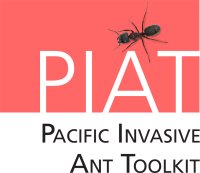Life cycle of ants
|
Simply put, there are three types of ants: queens, workers and males. Queens are responsible for all reproduction in the colony. The males live only to mate with new queens and die shortly thereafter. The workers, which are all female, are sterile and responsible for taking care of the brood (eggs, larvae and pupae), tending to the queen or queens, foraging for food and colony defense. Workers are the ants you are the most likely to see. As all the reproduction in the colony is done by the queens, any management method has to kill the queen (usually invasive ants have many queens). |

The three different kinds of ants: the large queen, the winged males and the many workers (© Meghan Cooling) |
Reproduction
Life cycle of an ant. It should be noted that the wings of new queens fall off after the first few days or weeks of the queen’s life (Source: Ask a Biologist (© Arizona Board of Regents / ASU Ask A Biologist) |
Ants have a unique life cycle compared to most other insects, which influences the methods needed to kill an entire colony. The life cycle of an ant is called complete metamorphosis. It is the same kind of life cycle butterflies have. Eggs are laid by the queen, and then hatch into larvae after 6-32 days, depending on the ant species and temperature. Larvae grow and are fed and cared for by the workers. In 12-32 days, the larvae then become pupae, and the workers stop feeding them. Pupae are covered by a white or brownish cocoon. When they are fully developed (9-30 days) adult ants emerge from the pupae. Workers are produced all year round in warmer regions, while reproductives (queens and males) are produced once a year, often at the beginning of the rainy season. Please visit the detailed information pages for the 5 worst invasive ant species for species-specific development times. |
| Pesticide control of ants relies on workers picking up the pesticide loaded bait and bringing it back to the colony to feed the queens and larvae. Pupae are not fed as they are in a cocoon.
As the pupae aren't fed the pesticide, when they come out of the pupal stage they can survive even though the rest of the colony may have been killed. It's a lonely life for these workers without their queens, but eventually they too will die. But queen and male pupae don't get fed the pesticide. When they come out of the pupal stage they can potentially start the colony all over again. This is why timing of insecticide treatment is important - ants must be at the right stage of their life cycle. |

Yellow crazy ant workers tending to larvae and pupae (© Meghan Cooling) |
Information sources
ASU School of Life Sciences, https://askabiologist.asu.edu/individual-life-cycle
Hoffmann, Auina, Stanley.2014. Targeted research to improve invasive species management: Yellow crazy ant Anoplolepis gracilipes in Samoa. PLOS ONE. 9:e95301
content reviewed by Souad Boudjelas, Pacific Invasives Initiative, November 2016

